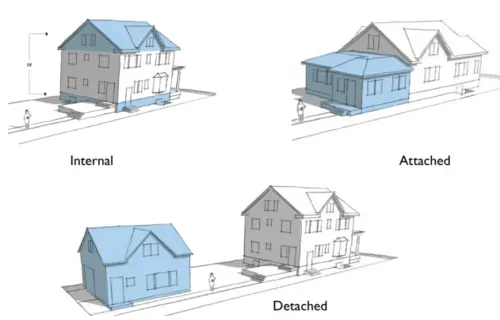Blog Archive

Why Second Suites Matter to the Province of Ontario?
“Adding a Second Suite” and “Duplex conversion”.
You may have you heard of them before. If you haven’t, they have become a popular investment strategy among many Ontario Real Estate Investors over the last decade.
When you’re finished reading this you’ll understand the essentials, including: what they are, how they came to be, and why they’re important to the future of housing supply in Ontario.
I’ll start with, “What are second suites?“
A second suite is a complete residential unit that is secondary, or subordinate, to the primary unit on a lot/property. They are defined as a self-contained separate unit which must include a separate entrance, full kitchen, full bathroom, living room, dining room and sleeping area(s).
Generally, they are permitted in single detached, semi-detached, row housing or an accessory structure. They are commonly referred to as additional dwelling units, second units, accessory dwelling units, basement apartments and/or in-law suites.
Accessory structures also have many names, including but not limited to, detached accessory residential units, garden suites, coach houses, backyard homes, carriage homes, and laneway suites.
A good start. And next, “How did they come to be?”
Legal second suites in the Province of Ontario are guided by the provincial policies within the Planning Act, Building Code Act, and Fire Protection and Prevention Act. It is important to note that there are many other Acts that can impede building on a particular lot. The Green Belt Act, Environmental Protection Act, and Endangered Species Act are some examples.
Although administered by the Ministry of Municipal Affairs and Housing it’s the individual Municipalities, under the Municipal Act, implementing these policies into their Official Plan. The exception to this is Northern Ontario where the Ministry directly oversees development.
To be permitted, second suites must meet certain zoning and by-law provisions, maintenance and/or property standards, building practices in the Ontario Building Code, fire and egress safety with the Ontario Fire Code, and in some instances licensing requirements. All of these measures are to ensure the health and safety of the residing occupants.
As previously mentioned, it is the individual municipalities which implement the provincial policies into their Official Plan. It is therefore important to note that this leaves room for slight variations from one municipality to the next depending on their interpretation.
In 15 Popular Ontario Cities Second Suite Zoning By-Laws I breakdown the applicable Zoning By-Laws in cities real estate investors are looking.
Researching each municipality’s mandates either online or by contacting the City’s planning and building department(s) to confirm exact requirements is vital before starting any project. This is especially true if you are planning to purchase a property with the intent to construct a second unit.
I recommend reading my step by step guides What You Need to Know About Legalizing a Second Suite? and A “How To” Guide For Second Suites in Ontario if you planning on going at it alone. It can be a daunting process for those with little to no experience. Consider using the services of a third party professional to guide you through it instead.
Okay, so I’ve covered the “What?” and “How?
Now, why do they matter for future development in the Province of Ontario?
One of the key considerations of second suites is residential intensification, defined by the Ministry of Municipal Affairs and Housing as
“…the development of a property, site or area at a higher density than currently exists, through development, redevelopment, infill and expansion or conversion of existing buildings.”
Simply put, it allows more people to connect, work and play within the existing urban boundary to meet growing demands including population growth, supply shortages, development constraints, and limited vacant land.
All of these have sent real estate prices sky rocketing over the last decade. With the increasing disparity between average salaries and rising real estate prices, home ownership is becoming more and more out of reach for many people. Creating affordable sources of housing is therefore needed now more than ever.
For more information on how the need for housing intensification and affordability has been encouraged by legislation, you can refer to my blog post titled “The History of Second Suites in Ontario” where I cover the last 25 years of provincial policies.
Second suites are a desirable form of housing intensification within existing neighbourhoods for many reasons. Firstly, they provide additional housing without supplanting the characteristics of the neighbourhood. Secondly, existing infrastructure such as public transportation and other city services are more efficiently utilized. Thirdly, increased supply of rental units in established developments reduces urban sprawl. Urban sprawl is the expansion of cities and towns often characterized by low-density, single-use, and private transportation.
When all is said and done, second suites are a WIN-WIN for property owners and renters. Individuals, couples, or families have an affordable place to live in a desirable location. While property owners are able are earning income to cover associated construction costs as well as the many expenses that come with property ownership. I’ll go into more of the numbers for property owners and future investors on why this makes sense in a future blog post titled “Analyze your Return on Investment”.
What Are Our Client Saying About Us?
OUR TESTIMONIALS

